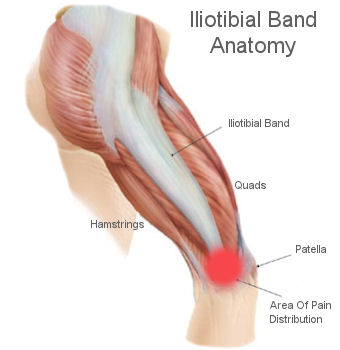Iliotibial Band Syndrom
The iliotibial band (ITB) runs along the outside of the thigh from the hip to the knee. At the hip it attaches to the TFL muscle (tensor fasciae latae) and works in harmony with gluteus medius & minimus to abduct and outwardly rotate the femur (thigh bone). It is a taut, thick band of fascia with very high tensile strength.
Iliotibial band syndrome can occur after rapid increase in mileage, or a lot of downhill running. Overpronation or a leg length discrepancy can also bring about the condition. As can weakness in the hip abductor muscles.
Interestingly, women are statistically more prone to ITBS due to the Q angle of the hips creating an increased risk of knee valgus (knee dropping inwards). Weakness in the hip abductors, including the gluteals lead to reduced control in hip motion which leads to the familiar knee drop (valgus). More stress is placed through the ITB & TFL so it tightens up in response and then creates irritation from increased friction. Pain is commonly felt on the outside of the knee and can radiate up and/or down the leg.
Iliotibial band syndrome is much easier to treat & manage if caught early and rehabilitation exercises are key to managing the condition.
Exercises that might help include lateral band walks, side leg lifts & one legged squats with a band. You can also foam roll the quadriceps, gluteals & TFL.
It’s best to avoid cycling but cross train with swimming, pool running and elliptical trainer. Also avoid running on cambered roads.
Things that may help include shortening your stride during running and increasing your cadence. A 5-10% difference in stride length can make a dramatic difference.
Exercises that promote stability and control of the hips such as; single-leg RDL’s, planks, bridges etc, help with muscular control around the hip. Strengthen those add and abductors and don’t forget to stretch.
WHEN TO STOP RUNNING – Pain on the outside of the knee that radiates up and/or down, especially when walking downhill or the stairs. Book an appointment with your sports therapist within the next few days.
CAUTION – Twinges on the outside of the knee 10 minutes into a run but go after a walking break. Mention when you next see your sports therapist.
GO – Pain free on the outer knee & thigh. Pain free after hills/stairs.
If you think you have iliotibial band syndrome and would like to get some advice you can book and appointment with one of our therapists HERE.

